 SCOPE SCOPE
SCOPE SCOPEIIA signs an MoU with the Karnataka RDPR Department
The Indian Institute of Astrophysics (IIA) signed a Memorandum of Understanding today with the Rural Development and Panchayat Raj (RDPR) Department of the Government of Karnataka to promote astronomy through the 5880 Arivu Kendras across the state.
 SCOPE SCOPE
SCOPE SCOPEEnd stages of stars like our Sun better explained with newer models for dust behaviour
Careful modelling of the thermal and ionization structure of a notable Planetary Nebula PN IC 2003, enabled astronomers from IIA to explain the observed multi-wavelength data much better than was possible by earlier researchers. IC 2003 is one of those rare Planetary Nebulae which has a hydrogen-deficient central remnant star of Wolf Rayet type. The astronomers used data from the Vainu Bappu Telescope in Kavalur, Tamil Nadu, which is operated by IIA, as well as data from other space telescopes.
This is based on the recently published paper titled "Photo-ionization structures of Planetary Nebula IC 2003 with [WR] central star", by Khushbu K. and C. Muthumariappan 2024, Advances in Space Research, 74, 3.
Press release by PIB published here.
Press release issued by DST here.
Download the paper from here.
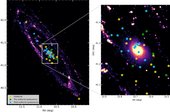 SCOPE SCOPE
SCOPE SCOPEUVIT on board AstroSat captures cosmic arsenal in Andromeda galaxy
Using Ultraviolet Imaging Telescope (UVIT/AstroSat) data of the Andromeda Galaxy from the public archives, astronomers from the Indian Institute of Astrophysics, Bengaluru have discovered ultraviolet emission from 42 novae, a special class of stellar explosions, and even caught 4 of them in the act of outburst itself. They could then study these interacting binary star systems in our nearest neighbor galaxy at different phases of their life, some piling up matter from their companion, while others spewing it into space.
Press release by PIB published here.
Press release issued by DST here.
Download the paper from here and here.
The paper was highlighted by Nature India as well.
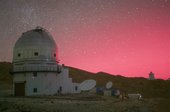 SCOPE SCOPE
SCOPE SCOPEAuroral activity seen again at Hanle in Ladakh on 10-11 October 2024
For an extraordinary fourth time during the current solar cycle, intense red coloured auroral activity was seen from Ladakh, India, and was photographed by astronomers of the Indian Institute of Astrophysics (IIA) from Hanle, Leh, and Merak on the night of 10-11 October 2024. The aurora was captured by the all-sky cameras at Hanle and Merak throughout the night. The bright red emission in the northern sky was seen easily with the unaided eye and the Observatory staff photographed it with their cameras as well.
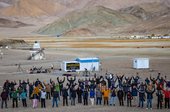 HDSR SCOPE
HDSR SCOPEThe Second Hanle Dark Sky Reserve Star Party observed in Ladakh
Expert astro-photographers and amateur astronomers came together at the Hanle Dark Sky Reserve between 29 September to 4 October 2024, for the second Star Party.
The unique event was organised by the Indian Institute of Astrophysics (IIA) an autonomous institute of the Department of Science and Technology (DST) in collaboration with Department of Wildlife Protection of UT Ladakh, and Bhabha Atomic Research Centre (BARC) and was attended by more than 45 astronomy enthusiasts from across the country. Hanle and the surrounding region are host to some of the darkest night skies in India. Hence, the Hanle Dark Sky Reserve (HDSR), centred around the Indian Astronomical Observatory, was notified by the Govt. of Ladakh in December 2022, and since then, it has been a major attraction for astro-tourism from across the country.
 SCOPE SCOPE
SCOPE SCOPEAstronomers map the differential rotation of the Sun's chromosphere using 100 years of Kodaikanal data
Using 100 years daily records of the Sun at the Kodaikanal Solar Observatory, astronomers have succeeded in mapping, for the very first time, the variation in the rotation speed of the Sun’s chromosphere, from the equator right up to its polar regions. The research can help give a complete picture of the Sun's inner workings.
This paper was published in the Astrophysical Journal, titled “Equator to Pole Solar Chromospheric Differential Rotation Using Ca-K Features Derived from Kodaikanal Data”, and was authored by Kharayat, Hema (Indian Institute of Astrophysics and M.L.K.P.G. College, Balrampur) and Singh, Jagdev, Priyal, Muthu and Ravindra, B. from Indian Institute of Astrophysics.
 SCOPE SCOPE
SCOPE SCOPERadio jet from dwarf galaxy discovered interacting with interstellar gas causing shock waves
Evidence of interaction between a radio jet emitted from special kind of galaxies called Active Galactic Nuclei (AGN) and the surrounding interstellar medium at small spatial scale of about 10 parsecs has been detected for the first time in a dwarf galaxy situated at a distance of about 14 million light years. This finding challenges the hypothesis that only large and massive galaxies jets from which regulate star formation, host AGN powered by massive black holes. Combining data from radio to X-ray wavebands from the galaxy NGC 4395, researchers from Indian Institute of Astrophysics (IIA), an autonomous institute of the Department of Science and Technology (DST) observed evidence for such an interaction at the scale of 10 parsecs, or about 30 light years, around the black hole at the centre of this galaxy.
This study was published in a paper in the Astrophysical Journal, titled “Evidence for Low-power Radio Jet–ISM Interaction at 10 pc in the Dwarf AGN Host NGC 4395”, and was authored by Payel Nandi (lead author), C.S. Stalin, and Ram Sagar from IIA, along with other collaborators spread across institutions in Europe and India.
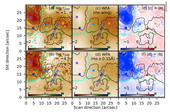 SCOPE SCOPE
SCOPE SCOPEKodaikanal Tower Tunnel Telescope probes deeper into Solar secrets
A new way to probe deeper into the Sun’s secrets has been found by studying the magnetic field at different layers of the solar atmosphere using data from the Kodaikanal Tower Tunnel Telescope. A study led by IIA researchers examined an active region (sunspot) with complex features, including multiple umbrae and a penumbra, through simultaneous observations in the Hydrogen-alpha and Calcium II 8662 Å lines from the Kodaikanal Tower Tunnel telescope. It provides a comprehensive analysis of the line-of-sight (LOS) magnetic field through these simultaneous observations. The results indicate that the Hα line core consistently infers weaker magnetic field strengths than the Ca II 8662 Å line inversions, suggesting that the Hα line samples higher atmospheric layers than the Ca II IR triplet.
Press release published here.
Download the paper from here.
 SCOPE SCOPE
SCOPE SCOPENew method to predict amplitude of upcoming solar cycle can forecast space weather
Astronomers have discovered a new correlation using 100 years of solar data from the Kodaikanal Solar Observatory, which will help predict the strength of an upcoming solar cycle maximum as well as help in space weather forecasting. The publicly available data from the observatory (which is celebrating 125 years this year) with a span of more than nine solar cycles, each cycle extending for about 11 years, was used to detect the large-sized (30,000 km) convective patterns called supergranulations on the visible surface of the sun. The analysis shows that these supergranular lane widths were positively correlated with the sunspot number.
Press release published here.
Download the paper from here.
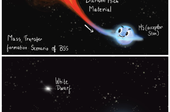 SCOPE SCOPE
SCOPE SCOPEAstroSat exposes the mystery of vampire star rejuvenation
Researchers have made a groundbreaking discovery of a vampire star in the star cluster M67 located in the constellation Cancer, that has been rejuvenating its youth by sucking up material from a companion. The study provides rare insights into the binary star evolution process and provides an important missing link in the rejuvenation in these stars. This discovery experimentally confirms the theoretical prediction that the vampire stars are formed by acquiring polluted matter through transfer from their companion, leaving behind a remnant white dwarf. The rarity of such chemically polluted systems is still a mystery and the team thinks that it may be due to the quick settling of the pollutants in the atmosphere of the vampire stars.
Press release published here.
Download the paper from here.